A tsunami in a teacup: when Tokyo goes nuclear against a French newspaper
by Jack Fourrier
Since the landslide victory of the Liberal Democratic Party (LPD) in December 2012 and Shinzo Abe’s return to power thereafter, the Japanese government has upped the ante with regards to communication. Yoshihide Suga, the Chief Cabinet Secretary, is the de facto spokesperson of this government and communicator extraordinaire. The 65-year old politician is in charge of promoting and publicising Abenomics, reining in vocal members of the Abe administration as well as coalition partners and allies, and making sure that Japan’s perceived best interests are protected.
There has been a growing sense of unease as the Abe government is faced with major challenges. On the home front, the aftermath of the March 2011 Great Tohoku Earthquake and Tsunami and the subsequent handling of the nuclear crisis at the Fukushima Daiichi plant has been a PR disaster for the former Administration and continues to plague the present government. Abenomics, a set of economic policies advocated by Prime Minister Abe and designed to put Japan back on track after the Lost Decade, is drawing criticisms and some circles voice concern as some of Abe’s initiatives threaten the sustainability of Japan’s economy. The country’s foreign policy is experiencing major shifts, what with Washington new Asia pivot policy and the territorial disputes on a backdrop of a more assertive China. Understandably, pressure is mounting on Abe and the government is pulling out all the stops to explain and justify its every move and decision.
In its September 11 edition, the French satirical weekly Le Canard Enchaîné published two controversial cartoons, one of them showing two emaciated sumo wrestlers with extra limbs competing next to a crippled nuclear plant and a sports commentator saying:
Marvellous! Thanks to Fukushima, sumo wrestling has become an Olympic discipline.
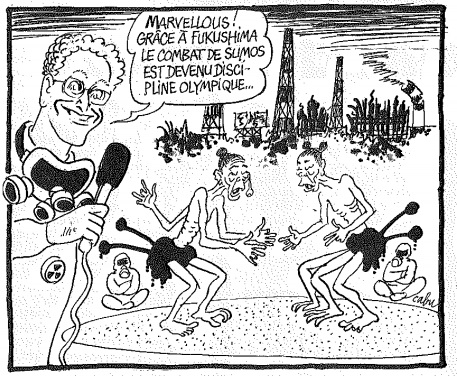
Yoshihide Suga reacted promptly, calling the cartoon insensitive and misleading.
This article will show that while Japan wants to play a bigger international role, its communication strategy remains demagogic, at odds with what is expected from a world power.
All pumped up against Le Canard Enchaîné
It wasn’t the first time: Le Canard Enchaîné took a few shots at Japan after the Fukushima disaster. The French satirical newspaper was created in 1915 and has been the bane of the political and cultural elite since then. It prides itself of a loyal readership, mainly through subscription, which in turn guarantees its independence and freedom of expression. The newspaper has a tradition of uncovering scandals through investigative journalism and leaks from officials. Le Canard Enchaîné is known for its impertinence and its cartoons, but also for its constant use of puns and spoonerisms, impossible to translate in a foreign language.
In its June 15, 2011 edition, three months after the Fukushima disaster, Le Canard Enchaîné published an article underscoring the findings made by the French Nuclear Safety Authority (IRSN). Abnormal quantities of iodine-131 and cesium-134 and cesium-137 originating from the crippled reactors were found in vegetables and goat’s milk in large areas of France. While the Authority claimed that these levels wouldn’t harm public health, an independent French research centre (Criirad) highlighted errors and inconsistencies in these measurements, pointing at higher levels of toxicity.
In its September 7, 2011 edition, the newspaper stressed that while international media focus has shifted from Fukushima, the situation is far from being solved. More importantly, it concludes :
The Japanese have started asking questions and have voiced their anger on Internet blogs: how have we come to believe the promises of such arrogant people? How have we allowed them to cheat us?
In its March 7, 2012 edition, Le Canard Enchaîné published an in-depth report on France’s fourth generation nuclear reactors. As the caption put it, “for the nuclear lobby, Fukushima is already a thing of the past…Whatever they say, the population has to take their word for it.”
In its September 26, 2012 edition, the newspaper jibed :
In Fukushima, everything’s fine. There’s a slight impediment though. The pool. Reactor number 4… Its roof has collapsed. A nondescript tarpaulin covers it.
According to experts, as quoted by the newspaper, a typhoon or a new earthquake would cause a disaster. It would be the “end of modern Japan.”
Two major events occurred in Japan after this date: the PLD won the general election on a bold economic platform in December 2012 and secured a majority in the House of Councillors, the upper house of the Diet in July 2013. Two months later, Tokyo was chosen to host the 2020 Olympics. Enter a more assertive Japan on the diplomatic arena. High on this agenda are the issues of territorial integrity and national sovereignty, the review of the military alliance with the Washington and the revision of the Constitution (Article 9) leading to the establishment of a full-fledged army. Moreover, Japan is looking outside its borders: Tokyo has been very active in strengthening economic cooperation and promoting trade with South East Asian countries and Africa. This all-out diplomatic offensive is echoed by a rhetoric verging on the irrational and openly nationalistic. Deputy Prime minister and Finance minister Taro Aso’s comments on the Constitution are an example of the actual mindset of Japan’s new rulers. On July 29, 2013, Aso declared that Japan’s government should learn from Nazi Germany, when the country’s “Weimar Constitution was changed before anyone noticing it.” He partially retracted his remark a couple of days after, saying that he wasn’t condoning Nazi Germany and that they were lessons to be learned from the failure of the Weimar republic. Prominent politicians in Japan have a tendency to refer to Nazi Germany, WW2 and controversial historical issues in a compulsive fashion. They suffer from the Basil Faulty’s syndrome (Faulty Towers). The more they say to themselves “don’t mention the war”, the more they feel compelled to mention it, either explicitly or implicitly. When Prime Minister Abe, in blue military jacket, wriggled into the cockpit of a T-4 training jet fighter of the Air Self-Defence Force on May 12, 2013, the number 731 was clearly visible in the fuselage of the aircraft. For most people in China and Korea, this number brings back memory of the notorious Unit 731, a covert biological and chemical warfare unit of the Imperial Japanese Army in China. This number should have evoked past atrocities to anyone present, but the Prime Minister chose to climb onto the jet.
Japanese leaders bitterly reminisce a fabled time when Japan was strong and they hanker after a new dawn for the country. Chairing the “Restoration of Sovereignty Day” on April 28, 2013 to mark the day in 1952 when the San Francisco Peace Treaty took effect, Shinzo Abe said:
We have a responsibility to make Japan a strong and resolute country that others across the world can rely on.
Emperor Akihito and Empress Michiko attended this highly symbolic ceremony and both were greeted by cheers from the participants, as they threw theirs hands up in the air shouting “Long Live the Emperor.” This rallying cry is a throwback of a nationalistic and militaristic Japan that most want to forget but still insidiously rears its ugly head in one of this world’s most advanced society.
Next on Prime Minister Shinzo Abe’s agenda is controlling its public communication, first and foremost the media. He proposed the nomination of five close allies at the board of governors of the NHK, Japan’s public broadcaster. The Diet approved their nominations on November 8. The board of governors will appoint NHK’s new president in January. There is little doubt as to the fate of what was left of editorial independence and critical reporting in this organization.
On the public relations front, the hyperactive Prime Minister and his cabinet have decided to be as reactive as possible for two reasons. First, there is undoubtedly a public malaise following the government’s response to the March 11 disaster and the responsibility of TEPCO in the Fukushima Daiichi meltdown. The government also continues to face criticism over the US presence in Okinawa. Other thorny issues related to the proposed free trade Transpacific Partnership, the recent tax hike and the country’s nuclear policy have prompted concern and reignited discontent in a broad swathe of the population. As the Japanese grow wary of their political elite, abstention in recent elections has reached record high proportions, leaving the grassroots political ground to activists, die-hard extremists and above all a large disillusioned electorate. The constant need to explain and justify decisions in the media highlights the lack of democratic debate. Who needs a democratic debate after all when the government appears to be doing its best on national television ? Who needs a democratic debate when officials relentlessly explain that nuclear power is safe ? Who needs a debate when the media are banging on about the China threat ?
This burst of activity in the media goes hand in hand with a proactive approach to public relations. The government needs to stoke up public indignation and resentment, resorting to fallacious argument.
On two occasions in September and October 2013, mainstream French media indulged in cheap jibes at Japan’s expenses. First, on September 11, Le Canard Enchaîné published the two cartoons, prompting the Japanese government to announce that a formal complaint will be lodged. According to Cabinet Secretary Yoshihide Suga, said that one of the cartoons is :
(…) inappropriate and gives a wrong impression of the Fukushima contaminated water issue.
Needless to say, apart from the temporary hullabaloo, the government decided to leave it to rest and didn’t lodge any formal complaint.
In another instance of typical French satire, on October 12, Laurent Ruquier, the host of one of France’s most popular TV talk show “On n’est pas couché”, ran a countdown of the ten best blunders of the week. According to Ruquier, the top one blunder of the week was the defeat of the French football squad against Japan 1-0. Ruquier went on to praise Konno, Japan’s defender, whose name in French means “idiot” (connaud) and the goalkeeper Eiji Kawashima. In the punch line, he attributed Japan’s victory to the “Fukushima effect” while a doctored picture of a four-armed Kawashima appeared on the screen.
Following the show, the Japanese government asked its embassy in France to protest. Jean Reveillon, the president of TV public channel France 2, apologized the following week on behalf of Ruquier for having “hurt the feelings of the Japanese people.”
Much ado about pumping
The first cartoon published by Le Canard Enchaîné on September 11, 2013, illustrated an article work in progress in Fukushima. Its main caption says:
Meanwhile in Fukushima, the Shadoks keep pumping…
More than two years after the disaster, the crippled plant is still heating up and leaking everywhere. Technicians cool it down and pump out the water at the same time. It could last for years.
The Shadoks is an animated TV series broadcast from 1968 to 1974 created by French cartoonist Jacques Rouxel. The series has gained cult status over the years for its post-1968 absurd take on human behaviour. The Shadoks are bird-like ruthless and stupid creatures living in a two-dimensional world. In their world, pumping was everything. Paraphrasing Descartes, they would say: “I pump, therefore I am.” One of the most famous absurd lines of this TV series was:
It’s best to pump even if nothing happens than risk something worse happening by not pumping.
The reference to the Shadoks is a case in point. Had the Fukushima incident been handled by the Shadoks, the situation wouldn’t have been different. Again the Shadoks:
Only when you pump can you get the job done, but even if you fail, at the end of the day, it’s not that terrible !
In this article, Le Canard Enchaîné makes a list of the inconsistencies and the blunders that have occured since the beginning of the incident. Even though Abe tried to reassure the International Olympic Committee in Buenos Aires on September 7, swearing, cross my heart, and hope to die, that everything was under control, the situation would be bordering on the grotesque if it wasn’t so tragic. This is what Le Canard Enchaîné wanted to convey, and what made the Japanese government so tetchy.
In the same edition of the newspaper, another cartoon greeted Tokyo’s hosting the 2020 Olympics in the same satirical fashion.
2020 Olympics in Japan: the swimming pool has already been built.
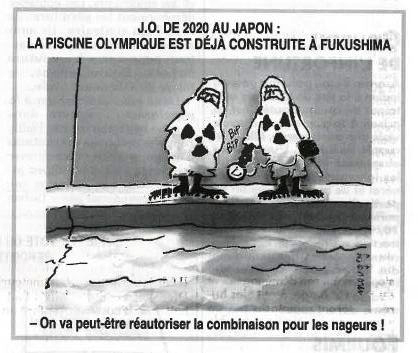
The cartoon shows two technicians donned in protective gear and standing by the pool, one of them holding a Geiger counter. The caption says:
They will probably allow swimsuits again in the swimming competitions !
Louis-Marie Horeau, the editor-in-chief of Le Canard Enchaîné, commented on the Japanese govenrment’s response, telling the AFP on September 12:
It’s not because we have a go at humour that we hurt the feelings of the victims. Here (in France), we can report on a tragedy in jest, but apparently, in Japan, that is not the case. We are absolutely stunned by this outburst and by the fact that such harmless cartoons have been so hyped. What is really outrageous is the way the Japanese government has managed the crisis.
We haven’t received any formal complaint yet, but a Japanese chargé d’affaires called us to say that things were fine in Fukushima.
Posturing has always been a strategic PR move in authoritatrian countries, but Japan has a democratic tradition – or has it really- that allows its government to take such harmless jibes with a pinch of salt and adopt a more dignified attitude.
Pump up the volume : Chinese posturing
In a recent example of posturing and feigned indignation, China has recently reacted to the ABC show Jimmy Kimmel! Live!
Aired on October 16, the show asked children how to solve the debt problem in the US. America owes China a lot of money, he said, how should we pay them back ? One of the children replied: “Kill everyone in China. ” A young Asian American girl, sitting next to him, them burst out laughing. Jimmy Kimmel echoed the answer, saying “That’s an interesting idea” in a tone that suggested how ridiculous it was. The show went on as all the children voice their opinion.
The reaction to the show was vociferous. Hundreds of American Chinese took to the streets and demanded that Jimmy Kimmel be dismissed. On October 19, a petition calling for the suppression of the program was posted on the White House website. Despite Jimmy Kimmel’s heartfelt apologies, the controversy showed no signs of ebbing. Enter Qin Gang, spokesperson for China’s Ministry of Foreign Affairs. What was an harmless and unintentional skit was treading into the troubled waters of diplomacy and business (diplobusiness), ABC being involved in the Disney Park project in Shanghai. On November 11, Qin Gang said :
Overseas Chinese in the US have spontaneously held demonstrations to protest the ABC’s offensive remarks against China. It must be pointed out that disseminating racial discrimination and hatred is against the social responsibility of the media. The ABC should squarely face its own mistake, make sincere response to the legitimate requirements of the overseas Chinese in the US and avoid the reoccurrence of similar incidents.
Notwithstanding the vagueness and the evasiveness of such a response, it is important to note that such trivial issues are now being discussed at the highest levels of the Chinese State in an exercise of demagogic point-scoring.
If you want something done wrong, do it yourself (The Shadoks)
China and Japan are respectively the world second and third largest economies but its leaders haven’t yet acknowledged that in an era of 24/7 rolling news, digital information and social media, these damage-control exercises are a vicious trap. Governments are now so intent on communicating that they are risking negative outcomes. There is obviously a disproportion of sorts between the stern rebuke of Japan’s Cabinet Chief and some inoffensive cartoons in an obscure French satirical newspaper. How could China’s Ministry of Foreign Affairs even comment on a late-night talk show broadcast in the US ?
In both instances, they have spun a yarn by distorting, deleting and generalizing. Now that readers and viewers have the means and the wherewithal to check directly for themselves and make up their own minds, governments need to refrain from comments that are nakedly beyond the pale. Why did Suga said that everything was fine in Fukushima when it’s a blatant lie? Why did Qin Gang ever evoke the worn rhetorical chestnut of racial discrimination and hatred ? If these two countries want to be seen as key players in the international diplomatic arena, they will have to consider more subtle ways of communicating or else, they might be at risk of losing any credibility or provoking unwanted outbursts of public anger.
 日本語
日本語 English
English 中国語
中国語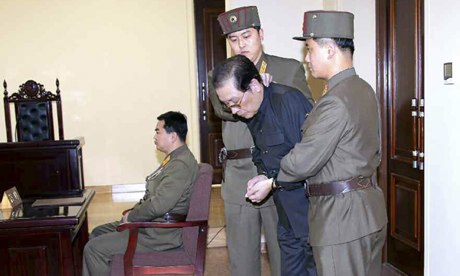 (Photo: Yonghap)
(Photo: Yonghap)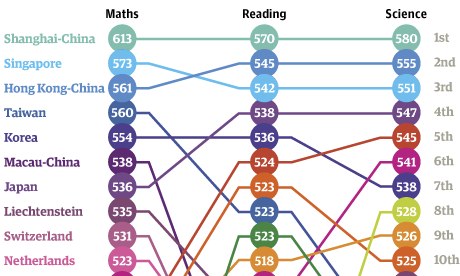 Graphic: OECD-PISA
Graphic: OECD-PISA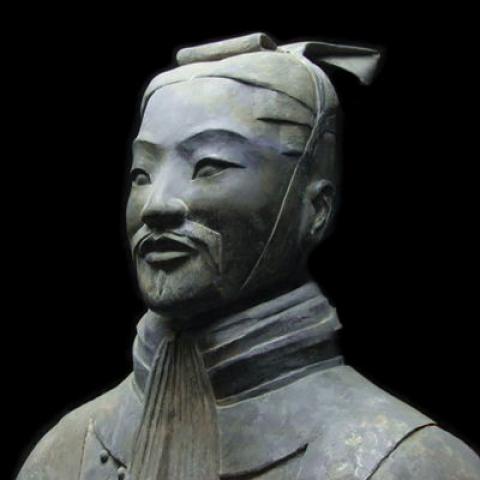
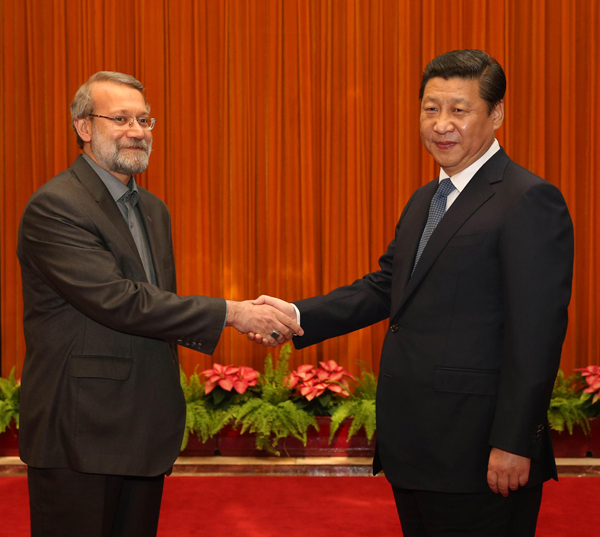 President XiJinping and Iranian Speaker Ali Larijani (Photo: FMPRC)
President XiJinping and Iranian Speaker Ali Larijani (Photo: FMPRC)
